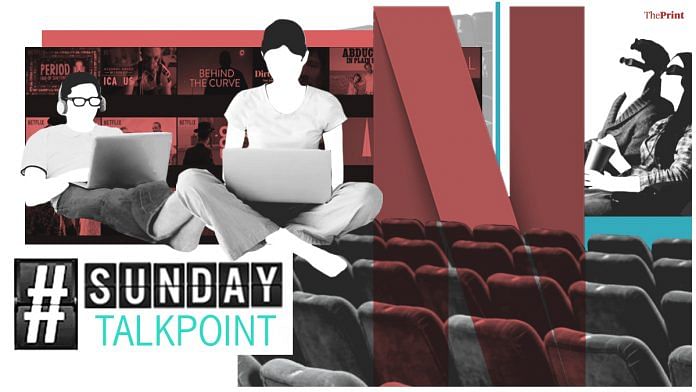Hit by lockdown, Indian film industry will lose an estimated Rs 2,500 crore, with PVR expecting theatres to reopen only by July-August. Streaming platforms such as Netflix and Hotstar are delighted. Amitabh Bachchan-starrer Gulabo Sitabo is set to premiere directly on Amazon Prime Video, which will follow it up with seven more releases in five Indian languages.
ThePrint asks: Is the future of cinema expensive, hygiene-friendly theatres or at-home Netflix experiences?
Few moviegoers will find the risk worth taking when the same content is available at home
 Swagata Yadavar
Swagata Yadavar
Assistant editor, ThePrint
For most part of the last two months, the majority of privileged Indians have stayed indoors and followed the lockdown rules. With more time at hand, people turned to Netflix and Amazon Prime Video and other streaming services like never before. Data shows a sharp rise in the daily and monthly consumption of online content during the lockdown.
However, even as the lockdown ends and life slowly gets back to pre-Covid normal, it is unlikely that most people will go back to their habit of watching movies in big screens of cinema halls. China, which reopened its theatres for a brief period in late March, saw few people turn up before the government ordered their closure again.
Apart from convenience and the cost factor, there are other reasons why watching movies at home is a better idea. Any activity in a crowded and closed space carries high risk of spreading the coronavirus. We know that fomite transmission — spread of the infection through inanimate objects — remains common. In theatres, anything from the side rest, 3D glasses, seat covers, tickets to popcorn packets can be a potential ‘carrier’ of the virus. While cinema halls will promise a thorough sanitisation, very few movie-goers will find the risk worth taking given the content is easily available at home.
If multiplexes in India ensure hygiene, distancing and safety, cinema-lovers won’t mind paying the extra buck
 Himani Chandna
Himani Chandna
Special correspondent, ThePrint
Watching a movie in a large group creates an atmosphere that gives an unexplained adrenaline rush. It turns an average movie into an experience that comes in ‘no-disturbance’ mode, which is difficult at home with Netflix.
Watching on Netflix, every time there’s a scene that I admire, my thought drifts to imagining it on a big screen. Cinema halls provide quality sound and breathtaking visual experiences that are impossible to get from Netflix.
And the coronavirus is not going to change people’s behaviour. After all, there’s a history to it. According to a report by BBC, “there was no single moment” during the 1918 Spanish flu pandemic “when all the cinemas in the UK shut, and some jurisdictions simply imposed mitigating measures”.
Drive-in theatres are gaining popularity abroad. If multiplexes in India ensure hygiene, distancing and safety, cinema-lovers won’t mind paying the extra buck, just like they never cared about paying Rs 500 for a fancy pop-corn tub.
Netflix, Amazon Prime Video have made watching movies more accessible, but can never replicate theatre experience
 Fiza Jha
Fiza Jha
Journalist, ThePrint
Over-the-top, or OTT, platforms like Netflix, Hotstar and Amazon Prime Video have made watching TV shows and movies more accessible than before, but they will never be able to replicate a theatre-going experience. This is perhaps why MUBI, Netflix’s cooler younger cousin, collaborated with PVR for special screenings as part of its membership, when it launched its MUBI GO app in India last year.
Most Indians access platforms like Netflix on their smartphones and computers, some middle-class Indians on their smart TVs. This small screen format is no match to watching a film at a movie theatre. Furthermore, the ease with which one can play, pause, rewind, switch movies while streaming completely takes away from the gravitas of watching something on the big screen, where one feels like they are witnessing something larger than life.
Indian cities and towns do not boast of too many public spaces where people can inhabit space leisurely. The movie hall, therefore, is a wonderful place that combines culture and community.
I think multiplexes, and even local single-screen cinema halls, are here to stay, but they will definitely require a new set of hygiene measures and take some time to revive.
Film industry must embrace streaming button and welcome new era in cinema if it wants to hold on to its audience
 Madhavi Pothukuchi
Madhavi Pothukuchi
Senior web editor, ThePrint
There’s no denying that the coronavirus pandemic has forever changed the way our world works. And while it’s good to remain optimistic that things will go back to normal at some point, it is also important to acknowledge the fundamental cultural shift taking place. And this shift includes the way we entertain ourselves.
Our million dollar entertainment industry, much of which depends on film distribution, and footfall in theatres, will have to restructure completely. Because the future of cinema is online streaming. It’s been coming for a few years now, with the ever-growing popularity of platforms like Netflix, Amazon Prime Video, and about a dozen others. Traditionalists resisted this, saying there is no match to experiencing a film on the big screen. Unfortunately, economics and human nature don’t work that way. Online streaming is more convenient, cost-effective, and therefore much more accessible.
The pandemic is acting as the final nail in traditional cinema’s coffin. When we needed entertainment and art more than ever, we were left with no option but to turn to online platforms. We can expect to see this trend until at least next year, as people try and overcome disease and mistrust.
Also, exclusively sanitised theatres will cut out the majority of Indians with the inevitable overpriced entry. If the industry wants to hold on to its audience, it will embrace the streaming button just like us and welcome a new era in cinema.
Also read: Hasan Minhaj back on Netflix: Will irreverent comedy work in dark Covid times?
By Pia Krishnankutty, journalist at ThePrint




The latter, one fears. Many pleasant memories of films wife and I saw in Calcutta when we were dating. Not just cinema halls, other industries too will be almost permanently altered. Discretionary spending will be hurt for a long time. Businesses should reorient themselves for austerity as the new normal.
It is most likely that Cinema will go the retail way slowly but gradually. Expect a lot of prime cinema real estate to be freed up for other purposes, perhaps urban warehouses for e-Commerce firms, to be closer to the customer base for quicker logistics.